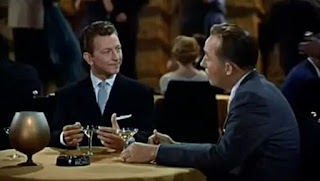Now you can own a piece of Danny Kaye’s life, thanks to an upcoming auction of many of his personal effects.
The auction, titled “Danny Kaye: A Showman’s Life,” contains more than 100 lots that will go under the hammer on May 3—or you can bid on them online right now at studioauctions.com.
The items were selected from the personal collection of an extremely close colleague of the Kayes, and are “first time to market;” they were all originally owned by Danny and/or Sylvia; given to their current owner as gifts from Danny, Sylvia or their daughter Dena; and have never been resold.
Among the prizes are themed dinner party invitations, Danny’s golf putter, Sylvia’s designer dresses, signed caricatures of Danny by Xavier Cugat and Hank “Dennis the Menace” Ketcham, contracts signed by guest stars on his TV variety series (Frank Sinatra, Louis Armstrong, Peter Falk, Clint Eastwood, Lucille Ball, et. al.), and personal letters from the likes of Harpo Marx, Humphrey Bogart, Jack Benny, and Gerald Ford.
Auction director Joe Moe said several of the items caught his eye—including the personal correspondence with Laurence Olivier and Vivian Leigh, Bill “Bojangles” Robinson-inscribed tap shoes, and Danny’s personal camera and collection of cigarette lighters.
My personal favorites: Danny’s passport and a photo of Eve Arden signed to Sylvia and Danny, during the time Eve was carrying on with Danny.
 |
Danny’s passport is signed, features a one-of-a-kind government-taken photo, and is stamped with his international trips during the 1960s. |
Once registering with Studio Auctions, there are four ways to bid:
(1) Absentee online – traditional online bidding, in which you list the maximum amount you’re willing to pay and the current bid adjusts up until your max is exceeded.
(2) In person – You can attend the live auction in Burbank, Ca., on Saturday May 3 at 10 am. Take your seat and a paddle to place your bids.
(3) Live by phone – The auction house will assign you a proxy in the room, who will place live bids for you and consult with you throughout. Moe described it as having “a companion who can gauge the mood and let you know what’s going on in the room.”
(4) Live on your keyboard – You advance bids yourself before and during the auction.
 |
Xavier Cugat sketched and signed this caricature of Danny Kaye to Danny in 1940. |
Each items lists an estimated value. The lower number is the reserve (the minimum amount required to submit a bid). However, if no bids are received, the item is considered passed upon, and interested parties can contact the auction house afterwards with lower bids that may be considered.
Those who have any questions about the items, can contact Studio Auctions. “We frequently receive inquiries about ‘condition reporting,” said Moe. “‘Is it engraved?’ ‘Is that a scratch?’” Parties can also make an appointment to view items at the auction house’s showroom in Burbank.
Happy bidding!
























